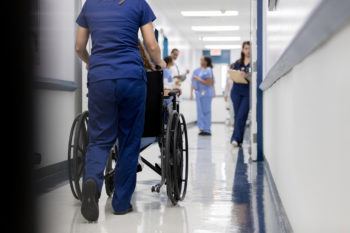Could A Wearable Patch Help Reduce Hospital Overcrowding?

Jessica Zamarripa, a graduate student in the Department of Materials Science and Engineering at Texas A&M University, and a team of international researchers are creating a wearable patch to help medical professionals remotely monitor patients’ vitals and reduce hospital overcrowding during and after the COVID-19 pandemic.
Zamarripa, a National Academy of Engineering (NAE) Grand Challenge Scholar, said the team, Postlytics, came together during the 2019 Global Grand Challenges Summit’s (GGCS’19) Innovation Hackathon Co-Lab that challenged groups to create a business model to address two global questions: “Can we sustain 10 billion people by 2050?” and “Will artificial intelligence and other transformational technologies change humanity for the better?”
Postlytics also includes Emily Cho from the University of Maryland, Luke He from the University of Nottingham Ningbo China, Asit Rahman from the University of Glasgow and the Royal Air Force and Morella Wang from Fuzhou University. The team aims to reduce overcrowding in hospitals by enhancing the ability for clinicians to monitor patients from afar. This would allow for those with less severe conditions to heal from home, while still being surveyed by medical staff.
“While hospital overcrowding is already a big issue across the globe, the issue will only increase as the global population is expected to rise to 10 billion people by 2050,” Zamarripa said. “Before the COVID-19 pandemic, we certainly did consider the potential use of our idea to help infectious diseases. With the onset of the pandemic, the team decided to primarily focus on pivoting to help the COVID-19 situation.”
Zamarripa said healthcare and other data resources such as the Organisation for Economic Cooperation and Development estimate there are as few as three hospital beds per 1,000 people available in the United States. The COVID-19 pandemic puts this shortage to the test, as hospitalization rates rise and lead to excess patients being boarded in emergency rooms. Such overcrowding causes inefficient patient care and a decreased ability for doctors to give patients proper attention.
The team’s solution to this issue is a wearable patch that monitors patient vitals such as temperature, cough detection, heart rate and electrocardiogram (ECG). This information is transmitted in real-time to healthcare professionals who can monitor the patient from afar, thus allowing for those in recovery or early stages of COVID-19 to be sent home.
The team’s new wearable design will use leading-edge materials for reusability and flexibility. The system will use data analytics and machine-learning algorithms to inform both healthcare professionals and patients.
Postlytics plans to build and test a fabricated prototype, apply for patents and the NSF National I-Corps Program (Innovation Start-up Incubator) and begin the U.S. Food and Drug Administration approval process.
“In the long term, we see many benefits and applications for enhancing remote monitoring capabilities on a hopefully global scale,” Zamarripa said. “With the COVID-19 pandemic, our primary focus is on using our solution to benefit hospitals and the overall healthcare industry; but we do see a wide range of applications to improve working and living situations in this social-distancing time.”
This article by Hannah Conrad originally appeared on the College of Engineering website.





